
Robohub.org
195
ICRA 2015 Company Showcase with Jens Hurley, Michael Ferguson, Simon DiMaio, François Boucher and Andrew Lewis
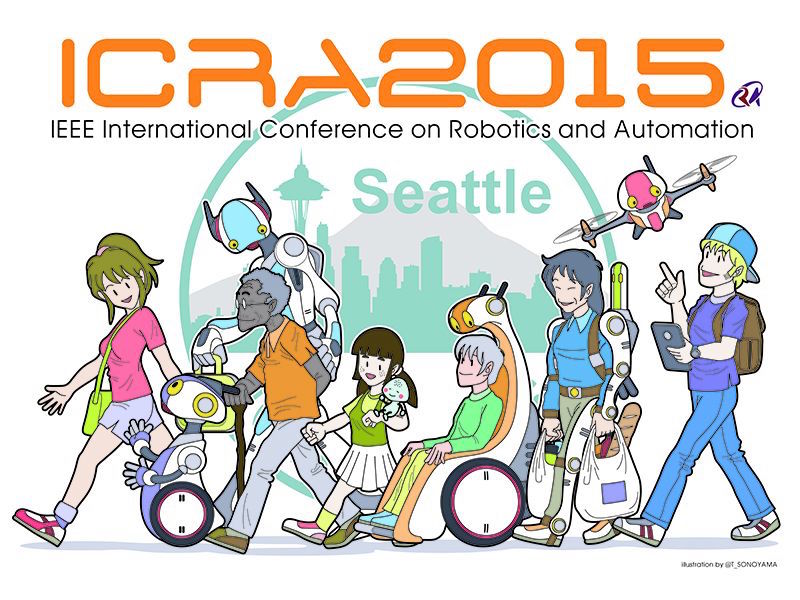

Transcript below
In this episode, Audrow Nash interviews several companies from the International Conferences on Robotics and Automation (ICRA) showcase. The companies span the following applications: mobile robots for military and commercial uses, warehouse solutions, robotic arms and manipulators, and robotic systems to assist surgery.
Companies are listed in the order of their interview with a picture of their booth at ICRA 2015. All photos were taken by Robohub and can be found here.
American Robot Company (AMBOT) specializes in advanced electronics, unmanned systems, autonomous vehicle solutions and intelligent platforms for research, commercial and military robotic applications.
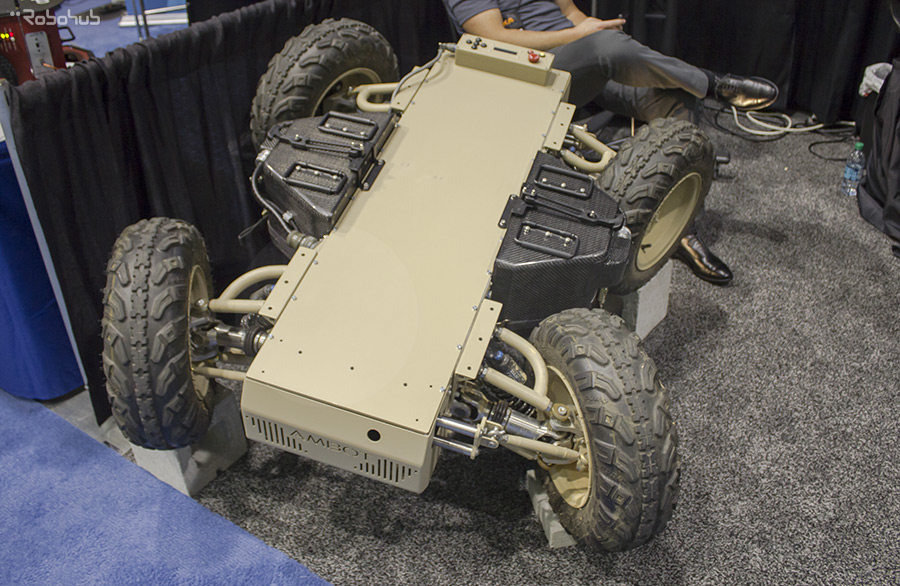
Fetch Robotics provides warehouse solutions.
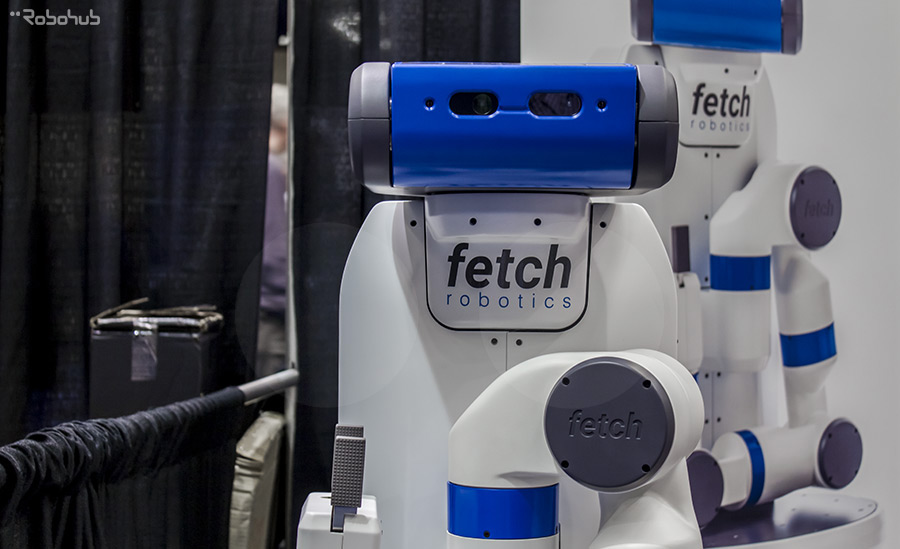
Intuitive Surgical designs and builds the da Vinci Surgical System for robotically assisted minimally invasive surgery.

Kinova designs and manufactures robotics platforms and components that are simple and safe under two business units: Assistive Robotics for people with disabilities and Service Robotics for humans and robots working in the same environments.
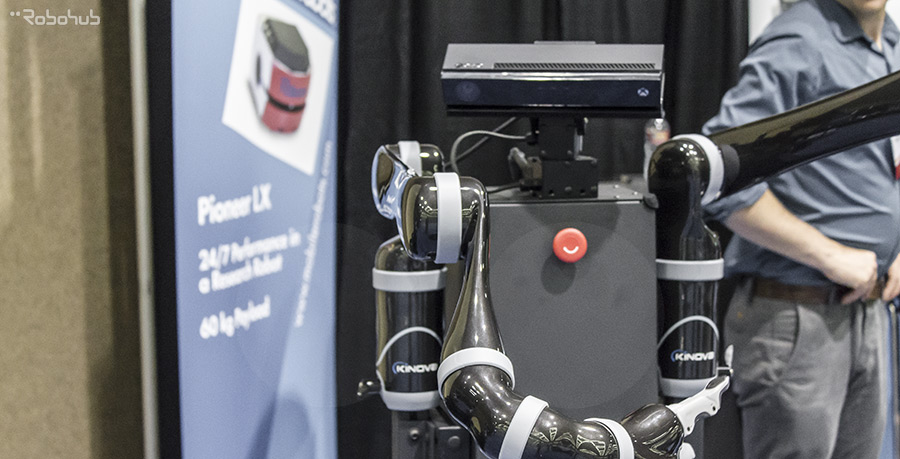
Applied Dexterity seeks to advance the field of robotically assisted surgery by creating a research surgical robot that can serve as a standard platform allowing researchers to share their software and improvements.
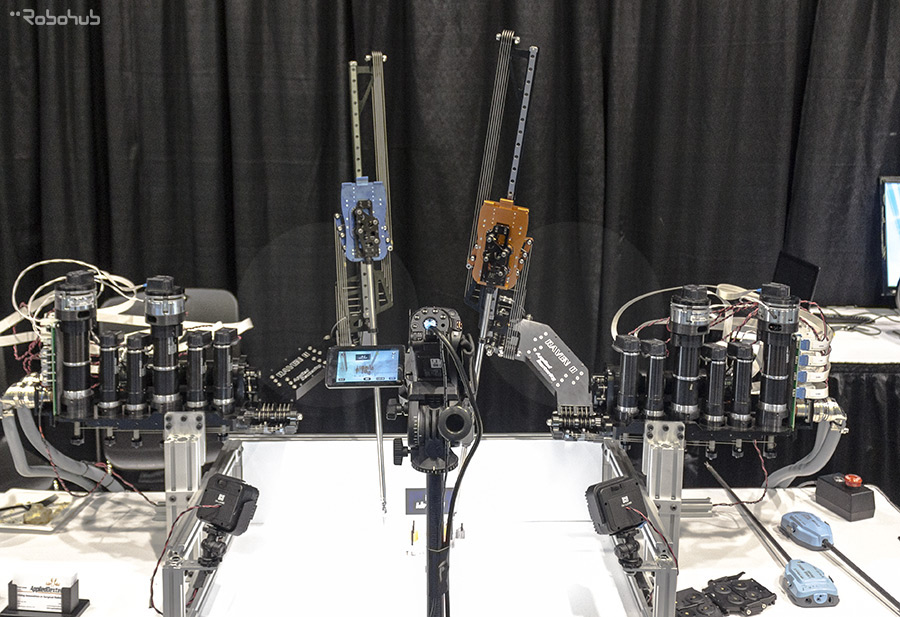
Interviewees
Jens Hurley is a Senior Roboticist at the American Robot Company.
Michael Ferguson is a Co-Founder and the Chief Technical Officer (CTO) of Fetch Robotics. Previously, Ferguson was the founder and CTO of Vanadium lab, developing low-cost education and hobby robot controllers, and a Software Engineer at Willow Garage.
Simon DiMaio is a Senior Manager of Research and Advanced Systems Development at Intuitive Surgical. Previously, DiMaio was an Instructor of Radiology and Postdoctoral Research Fellow at Harvard Medical School.
François Boucher is the Vice President of Business Development at Kinova Inc. in Boisbriand, Canada. He received his MBA and a Bachelor degree in Physics Engineering from Laval University. After his graduation, he worked as the General Manager of a technology transfer and investment company before joining Kinova in its early days to develop the service robotics market. In 2014 and 2015, Kinova was listed as one of the 50 most influential public & private companies in the global robotics industry by the Robotics Business Review and one of the fastest-growing company by Profit 500 in Canada.
Andrew Lewis is a Roboticist at Applied Dexterity. Previously, Lewis was a mechanical engineering graduate student in the BioRobotics lab at the University of Washington. His work in the BioRobotics Lab focused on the development of surgical robots, dynamically evaluated gravity compensation, and electromyography controlled iRobot Roombas. Lewis earned his BS in Robotics Engineering from Worcester Polytechnic Institute in 2011. His interests include mechanical design, systems development, and ethics in robotics engineering.
Links:
Transcript
Audrow Nash: Hi, can you introduce yourself.
Jens Hurley: My name is Jens Hurley. I’m a senior roboticist at AMBOT.
Audrow Nash: Can you tell me what you have set up at this booth?
Jens Hurley: Our booth is based on research mobility platforms. We’re doing a lot of ground robotics with a lot of autonomous function built into them.
Audrow Nash:This one right here, can you describe it a bit and then talk about its applications?
Jens Hurley: Absolutely, this guy is a ruggedized outdoor, high-speed, mobility platform. It weighs about 525 pounds. It can carry about 550 pounds, so it’s got a one-to-one payload ratio. It’s got four-wheel, steer independent suspension and four-wheel drive so it’s highly manipulative which makes it great for research applications. It also served in the military for a light and load application and medical evac. It has high-powered lithium ion batteries and a 8-10 hour runtime over difficult terrain.
Audrow Nash: How large is it and how tall?
Jens Hurley: Overall, I believe it’s about 52 inches long, about 42 inches wide and its ground clearance is about eight inches. The whole vehicle itself is about 19 inches from the ground.
Audrow Nash: It’s a large remote operated vehicle?
Jens Hurley: It can be. This particular one is set up for remote, a man in the loop. We also offer systems with autonomous functionality, like soldier following or vision based systems.
Audrow Nash: I see, and so it has these large carbon fibre capsules on its side. What do those do?
Jens Hurley: Those are actually our battery packs. They are quickly removable.
Audrow Nash: Why electric?
Jens Hurley: Silent operation, clean, quiet, overall a very nice function to have. A lot of applications in military require silent functionality.
Audrow Nash: What’s the max distance it could travel? Do you have an idea?
Jens Hurley: No, I couldn’t tell you the max distance. Runtime dependent about seven miles per hour for 10 hours, moving continuously.
Audrow Nash: 70 miles, okay. This vehicle looks like it has a very heavy suspension system.
Jens Hurley: It does.
Audrow Nash: Can you talk a bit about that?
Jens Hurley: Absolutely, it was developed to carry a high payload, heavy weight, under almost any conditions, so it’s got six inches of independent suspension at each corner which makes it contact with the ground. It’s very rugged, very durable.
Audrow Nash: How fast does it go?
Jens Hurley: This particular model has a top speed of about 40 miles per hour.
Audrow Nash: At those speeds why is good suspension valuable?
Jens Hurley: It’s key. If the payload’s too high – high centre of gravity – it’s just not a good thing to have at high speeds. The active suspension keeps the payload low, very stable, it’s physics.
Audrow Nash: Yes. Are there governments interested in this or are there other applications?
Jens Hurley: This particular robot here was developed for a military function, basically, to lighten the load of a soldier. The European space agency is using it for teleop, and universities such like John Hopkins and the Applied Physics Laboratory, are using it.
Audrow Nash: What do you mean by teleop?
Jens Hurley: It’s basically a man in the loop. So they’ll be operating from miles away to perform some sort of action.
Audrow Nash: Okay, so teleop and research applications. What about agriculture?
Jens Hurley: It’s something we’re looking into. There’s been a lot of interest here in agricultural purposes.
Audrow Nash: I see. What’s the purpose of the buttons?
Jens Hurley: It’s pretty standard that every robot comes with an emergency shut off: the red buttons. The rest of these are there for easy setup and control when you get it out of the package. A lot of the customers, when they get it up and going, move the onboard control system because they’re going to be controlling it from a distance.
Audrow Nash: I don’t really see how you put a payload on it, so describe it a little bit more. The wheels are a little bit taller than the body and the battery packs are a little higher than the body. Do you mount some sort of platform on it and then use the payload that way?
Jens Hurley: It depends on the application. A lot of payloads are being used just with manipulative arms and torsos and they do fit on the current payload space. If it’s something larger, like a palette size, we do offer mounting. There are hard mounting points located at each corner of the vehicle where we mount racks to elevate it up and off.
Audrow Nash: What about repair in the field?
Jens Hurley: Depending on what exactly has just broken down, it’s a very simple platform. Everything is open architecture, so it’s easy to get into, easy to repair. It’s a very straightforward, simple machine.
Audrow Nash: Are there standards in creating this? Do you use, for instance, one single size screw for accessing almost everything, or is there one tool to take apart most of it? Is there any modularity built in, so that you can quickly replace components?
Jens Hurley: Definitely. Most of the stuff is done in two metric sizes, M6 and M5, so it’s pretty much built together with the same hardware.
Audrow Nash: Thank you.
Jens Hurley: No problem.
Audrow Nash: Hi, can you introduce yourself.
Michael Ferguson: Yes, I’m Michael Ferguson. I’m the chief technology officer at Fetch Robotics.
Audrow Nash: Can you tell me about what you have set up at your booth?
Michael Ferguson: This week we are showing our new robot platform, Fetch. We’re letting people get up close and see the robot in person. Most people here at this show are particularly interested in the research edition of Fetch.
Audrow Nash: Can you tell me a bit about the robot and describe it.
Michael Ferguson: Sure. So, Fetch is a mobile manipulation platform, it has a mobile base that can drive around with a scanning laser in it to give it a view of the world and keep it localized. It has a torso that can rise up and down and attached to that we have a seven degrees of freedom arm. The gripper is a modularity point. Currently, we have a simple two-finger pincher on here.
Audrow Nash: What do you mean by modularity point, can you swap it?
Michael Ferguson: You can swap it, yeah. We have a standard specification on this, an ISO standard.
Audrow Nash: International Standards Organization?
Michael Ferguson: Yes. There are a number of vendors here at the show with really cool grippers that have, you know, sensors and all sorts of other stuff in them. And many of those will fit on our robot.
And then, lastly, the robot has a pan and tilt head, so that you can look in different directions, that’s carrying an RGB-D sensor. Colour and depth data are in 3D so you can see the whole world around you.
Audrow Nash: It’s a Microsoft Kinect or very similar?
Michael Ferguson: It’s a prime sense sensor, yeah, similar.
Audrow Nash: The robot has a wider base and that’s how it moves around. Then it has the centre part, that has the robotic arm and then above that is the vision, the depth sensor. What’s at the very base?
Michael Ferguson: It’s a scanning laser range finder.
Audrow Nash: Laser range finder? Is it only on a plane?
Michael Ferguson: It is on a plane, yeah. That’s actually manufactured by SIC.
Audrow Nash: Why seven degrees of freedom?
Michael Ferguson: Seven degrees of freedom give you really good dextrous manipulation. If you’re just picking things up off a table top, you probably don’t need a really dextrous arm, but if you want to reach into things, if you’ve got a complex cluttered environment, you really need the extra degrees of freedom there.
Audrow Nash: I see, and so it only has one arm and the arm is at the centre of the robot. Why this configuration? Is this so you can reach things?
Michael Ferguson: Yeah, there are two aspects to it. One is that two arms would make this robot significantly larger, heavier and bulkier. You want to navigate around human environments. We have skinny doors and things like that. The other is that very few applications really require two arms and, in many cases, if you did need a second arm, you just have a second robot come up and help and they can coordinate with each other. As far as the centre, really that’s for stability. There’s a very nice little tuck configuration for the arm that makes the platform extremely stable as the robot’s driving around – so that you can move quickly in the environment and not have to worry about your robot falling over.
Audrow Nash: So will this, primarily, be used for warehouse solutions to pick up products and put them into boxes to be shipped off somewhere? Is that what this has been designed for?
Michael Ferguson: We’re really designing to go into the logistics space, warehouse automation, pick and pack for items. There are videos on our website where you can see the robots doing those sorts of tasks.
Audrow Nash: If I’m not mistaken, the whole robot can rise up. Its spine kind of grows longer and that allows it to reach higher?
Michael Ferguson: Yes.
Audrow Nash: Okay, and how tall can it be?
Michael Ferguson: It gets up to about 1.7 meters or so. The exact specs are on our website. When you extend the arm all the way up you can still have some dextrous manipulability at about six foot.
Audrow Nash: You also mentioned that this could be a research platform. Can you tell me a bit about that?
Michael Ferguson: Yeah, we need a stable robot platform built on a operating system or ROS. We’re now making available our research edition, which has the robot hardware plus the open source side of navigation and some manipulation software, so that university labs can get a real jump-start. They don’t have to build robots by bringing pieces together. They have something that’s designed for mobile manipulation from the get go.
Audrow Nash: Thank you.
Michael Ferguson: Well you’re welcome.
Audrow Nash: Hi, can you introduce yourself.
Simon DiMaio: Sure, my name is Simon DiMaio. I work in our R&D group at Intuitive Surgical.
Audrow Nash: Now, can you tell me a bit about what you have set up at this booth?
Simon DiMaio: Sure, so this is called the Da Vinci Surgical system. It’s a system for minimally invasive surgery, for assisting surgeons to perform in a minimally invasive way. It does that by allowing the surgeons to control instruments inside the patient’s body from what we call a surgeon console. They can get very dextrous manipulation of surgical instruments while minimizing the invasiveness of the procedure for the patients. They fit these instruments through very small incisions in the patient’s abdomen, but still allow the surgeon to have control and dexterity.
To see the field in 3D, we have a stereo endoscope that allows the surgeon to see the inside, with very high quality HD images to control surgical instruments, like graspers and forceps and cutting instruments and electric quarter instruments, in a very natural way, almost as if they were inside the patient.
Audrow Nash: Now can you describe the Da Vinci a little bit.
Simon DiMaio: Absolutely, so there are really two main components in the Da Vinci. There’s the part that’s at the patient and this is where there are robotic manipulators for instruments that are inserted inside the patient. And that is a cart. It’s a mobile cart that carries four robotic arms. Usually, one of those arms carries the camera and the surgeon can control the pointing direction and the view that the camera sees. Then there are three additional arms that are usually used to manipulate instruments. Those can be for cutting, grasping, suturing and things like that.
Then, the other main piece is where the surgeon sits. They sit in an ergonomic console. You can think of it as kind of like a surgeon’s cockpit where they see the images from inside the patient. They see information from the system and they can interact and control by moving some really fancy joysticks, to control the movement of the instruments. They can interact with tissue from the other side of the room. Usually, the console is in the same room, connected to the rest of the system through a cable, but the surgeon controls the system from it.
Audrow Nash: The patient and cart, it kind of looks like a large hang man.
Simon DiMaio: Yeah.
Audrow Nash: It’s high, high above with the arms coming down.
Simon DiMaio: Correct.
Audrow Nash: It has four arms and each has a large tube that is inserted into the patient and that’s where the manipulators are and the camera.
Simon DiMaio: That’s right and that tube is called a trocar or a cannula and that’s the point of entry into the patient’s body. In order to create space for the surgeon to work in, the abdomen, or whichever cavity within the anatomy the surgeon is working on, would be inflated using carbon dioxide gas to create kind of a bubble. Those tubes that you referred to, the trocars or cannulas, have a seal on them, so that the carbon dioxide is trapped inside and maintained and so the instruments pass in and out of the body through that cannula, or trocar, through a seal.
Audrow Nash: I see, and so if they want different attachments, do they remove the inserted part from the arm and then swap in a new one?
Simon DiMaio: That’s correct. Yeah. They’re surgical articulated instruments that have wrists on them to mimic what the surgeon would want to do inside the body. Then there are a variety of end effectors or jaws that the instruments have. Some of them are for grasping tissue, like bowel, liver or kidney. Some of them are for cutting. Some of them are for suturing, so for handling needles. Those instruments are interchangeable on the system so they can be removed and replaced with different instruments depending on the task.
So, if the beginning of the procedure is a dissection, where you’re trying to expose tissues of interest, then you’ve got to remove some tissue and suture things back together. In each of those stages you would potentially use a different combination of instruments. So the system allows you to swap instruments during the procedure very quickly.
Audrow Nash: Is that the purpose of the fourth arm?
Simon DiMaio: The fourth arm could be managing retraction, for example, so it could be holding some tissue out of the way. You might be working underneath a liver or you might be working in an area where there is bowel and you might need to hold the bowel out of the way. It could be what’s called a suction irrigation instrument, that flushes the field with saline and then vacuums it out to manage blood and to keep the field dry and visibility good.
There are a variety of different things that you could use the fourth arm for. It could be used to manipulate an ultrasound probe. If the surgeon is looking at ultrasound images of the tissue and trying to see beyond visible surfaces in the endoscopic image, they might insert an ultrasound probe and manipulate that with the fourth arm. So it’s kind of an auxiliary arm that’s used for many different things.
Audrow Nash: I see.
Simon DiMaio: It can also be controlled from a second console so you can connect two consoles to the robot and have two surgeons.
Audrow Nash: When is that useful? Why?
Simon DiMaio: Training in one instance, if you have a proctor that’s training a mentor, a mentor that’s training a mentee, the proctor might be on one console and the trainee might be on the other. They can virtually swap instruments back and forth. So, a mentor might demonstrate a technique and then give control of the instruments to the trainee who can replicate those motions.
Another instance is if you have two experienced surgeons and they’re collaborating on a complex case, so that you can have all of the arms operating at the same time.
Audrow Nash: I see. How do you manage collisions between the arms? Does that happen?
Simon DiMaio: It does happen, the arm is working in very close proximity. Part of the design was to make the arms as skinny as possible so that they can work closer together. They’re pretty robust, so they can collide and they shouldn’t break.
Audrow Nash: Do they collide during surgery?
Simon DiMaio: They can collide during surgery and usually that happens when the surgeon’s trying to get the instruments very close together through a very narrow entryway. Some of the forces that occur during collisions are fed back into the console, so surgeons can feel some of them on the outside of the robot.
Audrow Nash: So there is some haptics.
Simon DiMaio: So there is some haptics. They don’t feel the very delicate interactions with tissue, but they can feel external collisions between the arms or perhaps with some rigid object. They get some feedback and they stop and investigate. There’s usually an assistant or nursing staff at the patient’s side that can warn them. But it happens quite often, and instruments work very closely together, it’s almost like if we were to stand side by side and our elbows were to knock against each other. It’s not a big deal, you keep going and that’s the nature of working in a confined space.
Audrow Nash: Now, can you tell me about the demo that you have set up at the booth?
Simon DiMaio: So we have a full Da Vinci system here and people are able to test-drive it. We’ve got a mannequin that has a simple plastic environment people can interact with. We’ve got some elastic bands so that they can get a sense of the intuitiveness of the motion of the arms. We also have a virtual reality-based simulator that’s used for training, basically a skills simulator that surgeons can use to learn how to tie knots and suture. They learn how to control the camera and the various instruments, and so are able to repeat the same skills and drills over and over again to develop muscle memory and familiarity with the system in a way that doesn’t require them to operate on patients or animals.
It’s a convenient way for people to use virtual reality models to hone their skills or to warm up before a procedure. So there are some surgeons that use the simulator like an athlete would do before a game. They might warm up and they might do some practice.
Audrow Nash: Interesting. Is there a certification procedure for doctors that are using the Da Vinci system in operations?
Simon DiMaio: There is a training path. I’m less familiar with that side of things but there is some training. I don’t believe that Intuitive directly certifies surgeons for using the system at their hospitals. That’s the responsibility of the hospital. But we provide some training, but we don’t train them on how to perform surgery, that’s something that they learn in med school, but we teach them how to use the tool and then hospitals decide how to certify.
Audrow Nash: What kind of feedback have you received from surgeons on the Da Vinci?
Simon DiMaio: Well, a variety of feedback. Obviously, there’s lots of interest in what they can do with it and what they can offer their patients. It’s a way of allowing surgeons to offer their patients an option for minimally invasive procedure where sometimes that’s not available. We get feedback related to the kinds of procedures that they can perform and the value of those procedures.
We also get feedback on the ergonomics of the system. For them, it’s being able to sit at a console in a fairly comfortable posture versus sometimes working in fairly awkward poses and configurations at the operating room table.
Obviously, there are lots of features that surgeons would like and so we get feedback on things that they’d like to see. It’s a work in progress, so we’re always interested in feedback; things that work well, things that they would like improved.
Audrow Nash: Thank you.
Simon DiMaio: You’re welcome.
Audrow Nash: Hi can you introduce yourself.
François Boucher: François Boucher, VP Business Development for Kinova Robotics.
Audrow Nash: Can you tell me what we have at the booth here?
François Boucher: Lighter, smooth, compact, efficient sets of service robotic arms. We have two different models, JACO and MICO with different ranges and size and weight.
Audrow Nash: First, what do you mean by service robotic arm?
François Boucher: Basically, it’s the opposite of industrial robotics. We’re not extremely fast and extremely precise, but we’re good at working around humans, in collaboration with them or with a human in the loop.
Audrow Nash: That means that they’re compliant to being touched, so if they bash into a human when it’s moving, it won’t hurt the human?
François Boucher: Yeah, exactly, but the arms are on top of all the features that we added: software and sensors. The arm itself weighs only five kilograms, including gripper control, so it won’t hurt anyone at that speed and that weight.
Audrow Nash: Very light, very cool. So how do you make them compliant? Is there a spring in them, like with Baxter?
François Boucher: No, it’s sensors in every actuator.
Audrow Nash: It generates a small electrical signal when you have force on the arm and it’s in the opposite direction?
François Boucher: Exactly.
Audrow Nash: How come you have a different approach? What’s the advantage to doing that over having like a spring in series with the actuator or pillow action?
François Boucher: Well, the fork gives us a safety feature but it also gives us a whole new range of applications, since the arm can now be speech controlled and not only just position controlled. With this whole new field of service robotics, that’s the kind of control that will be needed.
Audrow Nash: You mentioned two robots. What are they? Can you introduce me?
François Boucher: Yeah, it’s JACO and MICO. We started a company for assistive robotics, to mount robots on a wheelchair so that people can eat, drink, open doors, all by themselves. JACO was our first product five years ago.
Audrow Nash: How did you get its name?
François Boucher: It’s the name of the uncle of the founder of the company. He, himself, had muscular dystrophy. So, basically, you’re in a power wheelchair and you have limited motion in your arms. He was an inventor and he developed and built some sort of mechanical arm, with a cable from bicycle brakes and a motor from a windshield washer. It was our inspiration to start the company. His nickname was Jaco, so that’s why the robot’s named after him.
Audrow Nash: I see, and how did MICO get his name?
François Boucher: That’s an easy one. It’s a contraction of Mini and JACO so it turns out to be MICO.
Audrow Nash: Very cool. Can you tell me a bit about the grip and endefactors on these robotic arms?
François Boucher: Yeah, so for the assistive robotics purpose, we had to figure out how we could grip hundreds of different objects of different size and weight. We had to find a really versatile solution. We went with an under actuated gripper.
Audrow Nash: Tell me a bit about how it’s under actuated.
François Boucher: Basically, there’s one actuator per finger and, if you imagine, two tendons links with a spring.
Audrow Nash: I see. Okay.
François Boucher: So the great advantage with this gripper is that they are mechanically intelligent. We don’t have to worry much about which force we’re going to apply, how we’re going to grasp the object, since the flexible gripper adapts to its shape. So, with the precise force needed, we can grab an egg like we can grab a bottle of water.
Audrow Nash: You can grab an egg?
François Boucher: Yeah, exactly.
Audrow Nash: Surprising, that’s great. So, to grab an egg, do you have to tell it that it’s a soft object?
François Boucher: No, it’s really just a great mix of mechanical design and force imitation based on current. Sometimes people try to overdo things. We keep it simple and it works pretty well.
Audrow Nash: That’s interesting. Can you talk a bit more about that or is that IP?
François Boucher: It’s more experience than IP, I would say.
Audrow Nash: That’s kind of mind blowing for me. All right. So some of these don’t have any hands, robotic arms or graspers. What are you demonstrating there?
François Boucher: A lot of our arms are used in maintenance logistics, inspections or replacing a tool, a sensor or a camera. So the arm’s not only used for manipulation, but it can also be combined with a mobile mount platform to perform inspection and probing.
Audrow Nash: I see. Thank you.
Audrow Nash: Hi, could you introduce yourself.
Andrew Lewis: Sure, my name is Andrew Lewis and I’m a roboticist with Applied Dexterity and I’m here representing the Raven II and the Surgical Cockpit.
Audrow Nash: Tell me about the Raven II.
Andrew Lewis: The Raven II is an open source surgical robotics research platform. It was developed here at the University of Washington and then spun out into our start-up company, Applied Dexterity. We’ve helped to ship it around the world. Now there are about 18 or 19 labs around the world using Raven, or something similar.
Audrow Nash: Now, what stands out to me is open source surgical. Can you explain that a bit?
Andrew Lewis: Sure. So all the software is open source. It’s up on GitHub if you want to fork it and play around with it; throw it in your own version of Raven, if you’re that brave. The tooler face is also open source. We have a team, one of the original Raven teams that developed a Da Vinci adapter, and now we can use clinical Da Vinci tools on our robot and have access to their 150 plus tools without having to make them all ourselves.
Audrow Nash: Is most of the value you get from open sourcing this technology in low level parts of the software?
Andrew Lewis: Right. We’ve done all the low level parts and we’ve opened it all up so that researchers can look at anything they want. If they want to implement their own impedance control, or some other control techniques, they’re welcome to dive deep into the PID loops and what have you. You can just use some automation software, with some python scripts in ROS and, since all the source code is available to you, if something’s not working quite right you can change it yourself, or you shoot me an email and I’ll tell you how to change it, or change it for you.
Then, with the common platform, all of the schools or labs that have this robot can really lean on each other for advice on how to approach a problem.
If they’re having technical difficulties, they can check the forums and see that “oh yeah Harvard dealt with it a few years ago and they just unplugged this other thing.”
Audrow Nash: Is it largely research communities that are benefitting from this being open source?
Andrew Lewis: Yeah, so far we’ve distributed just to research labs to help us get in touch with hospitals about using this for research or training. But that would probably be a tighter, ready to roll, don’t-need-to-play-with-the-code version.
Audrow Nash: When we spoke about this a little bit ago, you mentioned that it’s not FDA approved.
Andrew Lewis: Right.
Audrow Nash: Can you talk a bit about what that means in term of its application for surgical, is it just a robot that is used in surgery first of all?
Andrew Lewis: The original version, the Raven I was used for Cholecystectomy, about a decade ago I guess.
Audrow Nash: I don’t know what that is.
Andrew Lewis: It’s gall bladder removal in a pig, and it was successful and I think that’s been the only real life surgery that’s been done with the robot. Harvard has started doing some work with it on time delay and tele-operation.
Since it’s not FDA approved, it means that, when a lab is looking to do some research with the platform that’s ready to go, they’re not paying for that FDA approval. The Da Vinci or another clinical systems is going run into millions of dollars because they’ve had to put time and a lot of effort into getting it approved.
Audrow Nash: That’s the advantage of it, the cost is kept down because it’s not FDA approved.
Andrew Lewis: Right.
Audrow Nash: I see. What’s kind of the goal do you have, where is the company heading?
Andrew Lewis: Our slogan is: “pushing the boundaries of surgical robotics.” The idea is to be able to make this platform available to research labs that are really pushing the boundaries and to support them wherever we can. Then we can make a lot of great connections in all these great labs.
And maybe try to license back some of the technologies that are coming out of the research community. And certainly learn a lot by just being around everyone, so we keep developing either surgical or tele-operated or autonomous systems, and gain huge advantages by being familiar with all these research topics.
Audrow Nash: Thank you.
Andrew Lewis: Sure.
tags: c-Events, Fetch Robotics, ICRA 2015, Intuitive Surgical




